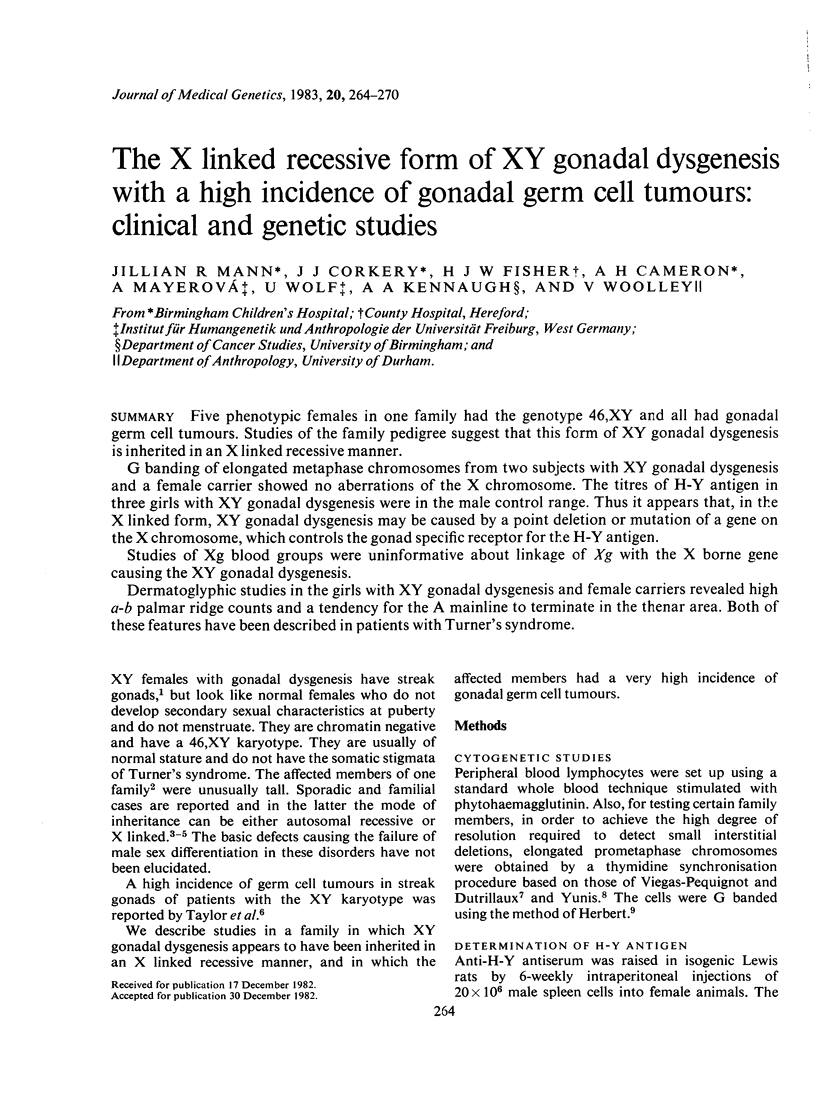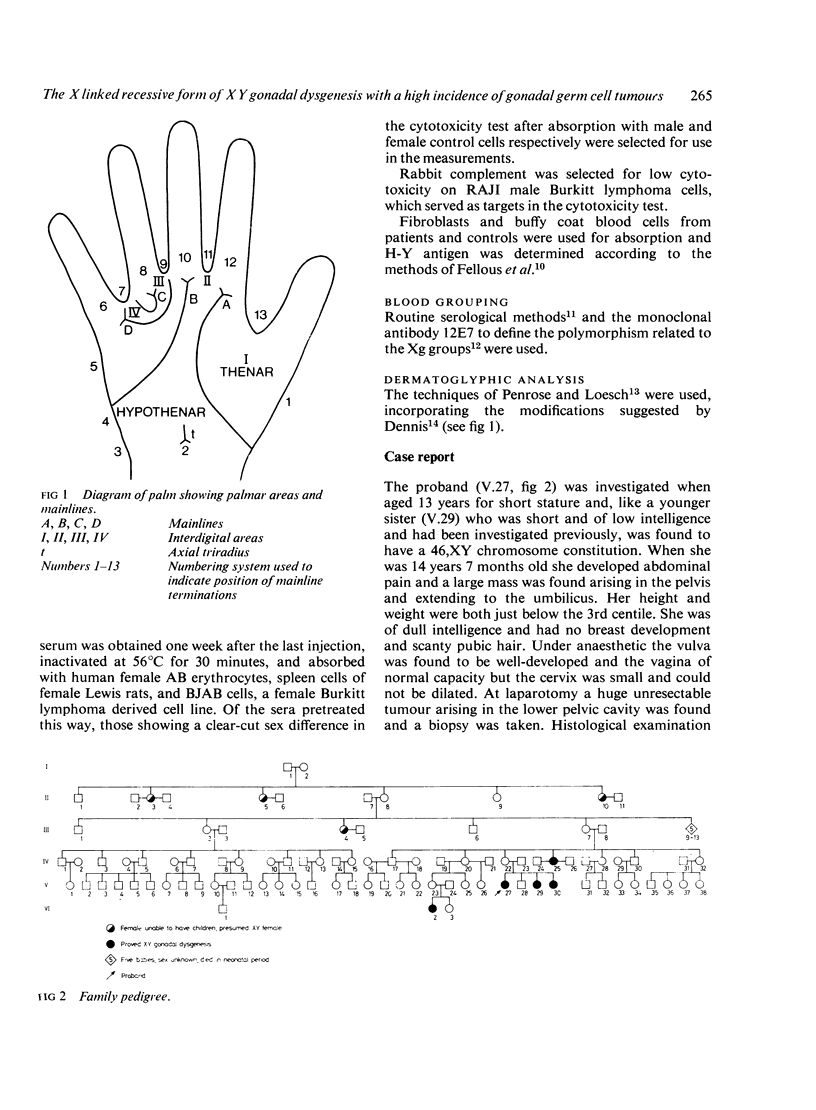Abstract
Five phenotypic females in one family had the genotype 46,XY and all had gonadal germ cell tumours. Studies of the family pedigree suggest that this form of XY gonadal dysgenesis is inherited in an X linked recessive manner. G banding of elongated metaphase chromosomes from two subjects with XY gonadal dysgenesis and a female carrier showed no aberrations of the X chromosome. The titres of H-Y antigen in three girls with XY gonadal dysgenesis were in the male control range. Thus it appears that, in the X linked form, XY gonadal dysgenesis may be caused by a point deletion or mutation of a gene on the X chromosome, which controls the gonad specific receptor for the H-Y antigen. Studies of Xg blood groups were uninformative about linkage of Xg with the X borne gene causing the XY gonadal dysgenesis. Dermatoglyphic studies in the girls with XY gonadal dysgenesis and female carriers revealed high a-b palmar ridge counts and a tendency for the A mainline to terminate in the thenar area. Both of these features have been described in patients with Turner's syndrome.
Full text
PDF






Selected References
These references are in PubMed. This may not be the complete list of references from this article.
- Chemke J., Carmichael R., Stewart J. M., Geer R. H., Robinson A. Familial XY gonadal dysgenesis. J Med Genet. 1970 Jun;7(2):105–111. doi: 10.1136/jmg.7.2.105. [DOI] [PMC free article] [PubMed] [Google Scholar]
- Espiner E. A., Veale A. M., Sands V. E., Fitzgerald P. H. Familial syndrome of streak gonads and normal male karyotype in five phenotypic females. N Engl J Med. 1970 Jul 2;283(1):6–11. doi: 10.1056/NEJM197007022830102. [DOI] [PubMed] [Google Scholar]
- Fellous M., Günther E., Kemler R., Wiels J., Berger R., Guenet J. L., Jakob H., Jacob F. Association of the H-Y male antigen with beta2-microglobulin on human lymphoid and differentiated mouse teratocarcinoma cell lines. J Exp Med. 1978 Jul 1;148(1):58–70. doi: 10.1084/jem.148.1.58. [DOI] [PMC free article] [PubMed] [Google Scholar]
- German J., Simpson J. L., Chaganti R. S., Summitt R. L., Reid L. B., Merkatz I. R. Genetically determined sex-reversal in 46,XY humans. Science. 1978 Oct 6;202(4363):53–56. doi: 10.1126/science.567843. [DOI] [PubMed] [Google Scholar]
- Goodfellow P. N., Tippett P. A human quantitative polymorphism related to Xg blood groups. Nature. 1981 Jan 29;289(5796):404–405. doi: 10.1038/289404a0. [DOI] [PubMed] [Google Scholar]
- Herbert A. High resolution banding of prometaphase chromosomes. Hum Genet. 1982;61(1):63–64. doi: 10.1007/BF00291335. [DOI] [PubMed] [Google Scholar]
- Isurugi K., Aso Y., Ishida H., Suzuki T., Kakizoe T., Motegi T., Nishi T., Aoki H. Prepubertal XY gonadal dysgenesis. Pediatrics. 1977 Apr;59(4):569–573. [PubMed] [Google Scholar]
- Penrose L. S., Loesch D. Topological classification of palmar dermatoglyphics. J Ment Defic Res. 1970 Jun;14(2):111–128. doi: 10.1111/j.1365-2788.1970.tb01106.x. [DOI] [PubMed] [Google Scholar]
- Shapiro L. J., Mohandas T., Weiss R., Romeo G. Non-inactivation of an x-chromosome locus in man. Science. 1979 Jun 15;204(4398):1224–1226. doi: 10.1126/science.156396. [DOI] [PubMed] [Google Scholar]
- Simpson J. L., Blagowidow N., Martin A. O. XY gonadal dysgenesis: genetic heterogeneity based upon clinical observations, H-Y antigen status and segregation analysis. Hum Genet. 1981;58(1):91–97. doi: 10.1007/BF00284155. [DOI] [PubMed] [Google Scholar]
- Simpson J. L., Christakos A. C., Horwith M., Silverman F. S. Gonadal dysgenesis in individuals with apparently normal chromosomal complements: tabulation of cases and compilation of genetic data. Birth Defects Orig Artic Ser. 1971 May;7(6):215–228. [PubMed] [Google Scholar]
- Taylor H., Barter R. H., Jacobson C. B. Neoplasms of dysgenetic gonads. Am J Obstet Gynecol. 1966 Nov 15;96(6):816–823. doi: 10.1016/0002-9378(66)90677-6. [DOI] [PubMed] [Google Scholar]
- Tiepolo L., Zuffardi O., Fraccaro M., di Natale D., Gargantini L., Müller C. R., Ropers H. H. Assignment by deletion mapping of the steroid sulfatase X-linked ichthyosis locus to Xp223. Hum Genet. 1980;54(2):205–206. doi: 10.1007/BF00278973. [DOI] [PubMed] [Google Scholar]
- Wiberg U., Mayerová A., Müller U., Fredga K., Wolf U. X-linked genes of the H-Y antigen system in the wood lemming (Myopus schisticolor). Hum Genet. 1982;60(2):163–166. doi: 10.1007/BF00569705. [DOI] [PubMed] [Google Scholar]
- Wolf U., Fraccaro M., Mayerová A., Hecht T., Zuffardi O., Hameister H. Turner syndrome patients are H-Y positive. Hum Genet. 1980;54(3):315–318. doi: 10.1007/BF00291575. [DOI] [PubMed] [Google Scholar]
- Wolf U. XY gonadal dysgenesis and the H-Y antigen. Report on 12 cases. Hum Genet. 1979 Apr 5;47(3):269–277. doi: 10.1007/BF00321019. [DOI] [PubMed] [Google Scholar]
- Yunis J. J. High resolution of human chromosomes. Science. 1976 Mar 26;191(4233):1268–1270. doi: 10.1126/science.1257746. [DOI] [PubMed] [Google Scholar]


